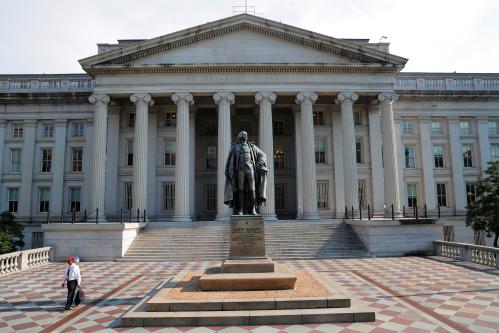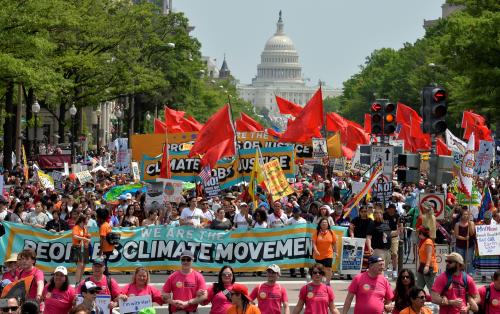The Vitals
It is rare to find common ground between Democrats and
Republicans these days, but one thing they share is a renewed interest in targeted
government support for certain sectors, industries, businesses, or
technologies. Such support—generically known as “industrial policy”—can take
the form of trade protection, tax credits, direct subsidies, loan guarantees,
or otherwise favorable government loans.
While President Trump and the various Democratic presidential candidates favor some form of industrial policy, they differ on the question of who should benefit from targeted government support. The president tends to favor traditional manufacturing and fossil fuels industries, whereas the Democrats lean toward “green manufacturing” such as renewable energy.
-
Both President Trump and the Democratic candidates favor government support for manufacturing, but differ on which industries should get support.
-
President Trump favors government investments in traditional manufacturing jobs, while Democratic candidates support cleaner, greener manufacturing.
-
While opponents of industrial policy argue that it is dangerous for the government to pick “winners” and “losers,” proponents believe it is vital for keeping the U.S. competitive and for job creation.
A Closer Look
Industrial policy: Arguments for and against
The merits of industrial policy have been debated for at
least a century. Cecil Pigou, an early 20th century English economist, explained
the tension between theory and practice this way: In theory, “economic welfare
would be increased by granting bounties to industries falling into one category
and by imposing taxes on those falling into another.” In practice, though, “we
are not able to say which of our categories the various industries of real life
belong.”
That captures the views of today’s proponents and opponents
of industrial policy. Proponents argue that targeted government support is
needed for the U.S. to remain competitive with other countries (especially
China) in certain vital industries, that some worthwhile industries or
technologies need support in their early stages to become viable, and that the
government should support some sectors (such as manufacturing) over others
(such as services) because they provide well-paid and stable jobs for the
working class, jobs that they consider essential for a healthy society. The
common theme is that a market economy will underinvest in certain important and
identifiable areas.
Opponents argue that it is dangerous for government to pick
“winners” and “losers.” They argue this will lead to economic decisions based
on political rather than economic considerations, resulting in cronyism and a
weaker economy. Opponents also don’t believe that industrial policy creates
jobs, but instead simply attracts workers from other employers. The common
theme among opponents is that by replacing the market decisions of consumers,
investors, entrepreneurs, and businesses with decisions by less-informed and politically
motivated government officials, the economic welfare of the nation suffers. They
prefer policies like a carbon tax, which applies broadly across sectors that
emit carbon, or government support for research and development, rather than specifically
targeted subsidies.
Both sides of the industrial policy debate cite historical
examples in support of their views. President Trump’s promise to “Make America
Great Again” is in some ways a reference to mid-century government efforts to
promote the nation’s industrial base. Similarly, in justifying her Green
Manufacturing Plan, Sen. Elizabeth Warren, the Massachusetts
Democrat, cites examples of the late 1930s, when the U.S. government responded
to Nazi aggression by “mobilizing its industrial base,” and the U.S. government’s
effort in the 1960s to win the space race. Sen. Bernie Sanders of Vermont
compares his plan to combat climate change to “the crises faced by President Franklin
Delano Roosevelt in the 1940s.” Opponents frequently cite Japan’s industrial
policies, which were frequently viewed in the 1970s and 1980s as a threat to
American competitiveness, but were later blamed for contributing to Japan’s 20
plus years of weak growth in the 1990s and 2000s.
Since there is no precise definition of what constitutes
“industrial policy,” there can be no clear evidence on its effectiveness. There
are many examples of targeted government interventions that did not yield
results. In the energy sector alone, these include subsidies for solar power
maker Solyndra, the Clinch River breeder reactor project, the Synthetic Fuels
Corporation, and the hydrogen car. However, a more appropriate assessment would
include aggregating the winners as well as the losers to assess the
effectiveness of energy subsidies as a whole. A 2001 National Academy of
Sciences report
on energy efficiency and fossil energy programs suggests that they yielded net
benefits.
President Trump’s industrial policies
Industrial policy has been a key component of President
Trump’s agenda. Within weeks of the 2016 election, he intervened in the
decision by Carrier,
an Indiana-based heating and air-conditioning manufacturer, to relocate some of
its production to Mexico. He threatened to make Carrier’s receipt of tax
credits conditional on not relocating the jobs and he threatened U.S. firms
with tariffs if they were to relocate plants overseas.
The Carrier case, which tied specific government benefits
and penalties to a specific business decision by a specific company, is a
narrowly targeted instance of industrial policy. But it is just one example of
President Trump threatening to pull federal subsidies from companies that
consider moving production overseas. The Trump administration has also embraced
industrial policy on a broader scale, such as in its executive
order calling on the secretary of defense to assess and strengthen America’s
manufacturing and defense industrial base. The executive order cites the need
for “policies that support job growth in manufacturing and the defense
industrial base” in order to, among other things, address the “loss of
factories and manufacturing jobs” and the decline of “workforce skills
important to national defense.” The lead recommendations of the subsequent
report are to “create an industrial policy in support of national
security efforts” and “expand direct investment in the lower tier of the
industrial base.” Finally, the Trump administration has used tariffs on
particular goods (such as steel and aluminum) as a way to protect domestic
industries it deems at risk from foreign competition.
Democratic candidates’ industrial policies
Whereas President Trump’s industrial policies are focused on
manufacturing in general, Democratic presidential candidates are more focused
on promoting manufacturing jobs that are related to addressing climate change.
Most of the major Democratic candidates support the Green New Deal, which calls
on the government to “spur massive growth in clean manufacturing.”
Sen. Sanders’s plan is to “create millions of union,
family-wage jobs through the Green New Deal in steel and auto manufacturing,
construction, energy efficiency retrofitting, coding and server farms, and
renewable power plants” and commits to spending “$1.52 trillion on renewable
energy and $852 billion to build energy storage capacity.”
Sen. Warren proposes a “Green Manufacturing Plan” that
offers “big and bold investments in American research, American industry, and
American workers.” Her plan includes a $1.5 trillion federal procurement
commitment over the next 10 years to purchase American-made clean, renewable,
and emission-free energy products for federal, state, and local use, and for
export,” as well as “a new federal office dedicated to selling American-made
clean, renewable, and emission-free energy technology abroad.”
Similarly, Vice President Joe Biden proposes a “Clean Energy
Revolution” to address climate change and to “create new industries that
reinvigorate our manufacturing [sector] and create high-quality, middle-class
jobs.” His plan includes a “federal investment of $1.7 trillion over the next
ten years” and “using the federal government procurement system … to drive
towards 100% clean energy and zero-emissions vehicles.”
Points of agreement and disagreement
There is now broad agreement among Democratic and Republican politicians that government should endorse industrial policies, in particular by directing government support for the manufacturing sector. Where they differ is on whether this support should be directed more toward traditional (more carbon-intensive) manufacturing or to cleaner, greener manufacturing industries. This contrasts with the preferred approach of many academic economists, who favor broader, less targeted government support, such as subsidies for research and development or, in the case of climate policy, an economy-wide carbon tax to spur the market to reduce emissions.







Commentary
Should government directly support certain industries?
March 4, 2020